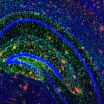(Press-News.org) VIDEO:
UC Davis engineer Saif Islam explains how growing semiconductor nano-sized wires and bridges on silicon can lead to a new generation of robust electronic devices.
Click here for more information.
A new approach to integrated circuits, combining atoms of semiconductor materials into nanowires and structures on top of silicon surfaces, shows promise for a new generation of fast, robust electronic and photonic devices. Engineers at the University of California, Davis, have recently demonstrated three-dimensional nanowire transistors using this approach that open exciting opportunities for integrating other semiconductors, such as gallium nitride, on silicon substrates.
"Silicon can't do everything," said Saif Islam, professor of electrical and computer engineering at UC Davis. Circuits built on conventionally etched silicon have reached their lower size limit, which restricts operation speed and integration density. Additionally, conventional silicon circuits cannot function at temperatures above 250 degrees Celsius (about 480 degrees Fahrenheit), or handle high power or voltages, or optical applications.
The new technology could be used, for example, to build sensors that can operate under high temperatures, for example inside aircraft engines.
"In the foreseeable future, society will be dependent on a variety of sensors and control systems that operate in extreme environments, such as motor vehicles, boats, airplanes, terrestrial oil and ore extraction, rockets, spacecraft, and bodily implants," Islam said.
Devices that include both silicon and nonsilicon materials offer higher speeds and more robust performance. Conventional microcircuits are formed from etched layers of silicon and insulators, but it's difficult to grow nonsilicon materials as layers over silicon because of incompatibilities in crystal structure (or "lattice mismatch") and differences in thermal properties.
Instead, Islam's laboratory at UC Davis has created silicon wafers with "nanopillars" of materials such as gallium arsenide, gallium nitride or indium phosphide on them, and grown tiny nanowire "bridges" between nanopillars.
"We can't grow films of these other materials on silicon, but we can grow them as nanowires," Islam said.
The researchers have been able to make these nanowires operate as transistors, and combine them into more complex circuits as well as devices that are responsive to light. They have developed techniques to control the number of nanowires, their physical characteristics and consistency.
Islam said the suspended structures have other advantages: They are easier to cool and handle thermal expansion better than planar structures — a relevant issue when mismatched materials are combined in a transistor.
The technology also leverages the well-established technology for manufacturing silicon integrated circuits, instead of having to create an entirely new route for manufacturing and distribution, Islam said.
The work is described in a series of recent papers in the journals Advanced Materials, Applied Physics Letters and IEEE Transactions on Nanotechnology with co-authors Jin Yong Oh at UC Davis; Jong-Tae Park, University of Incheon, South Korea; Hyun-June Jang and Won-Ju Cho, Kwangwoon University, South Korea. Funding was provided by the U.S. National Science Foundation and the government of South Korea.
INFORMATION:
Nanowire bridging transistors open way to next-generation electronics
2014-05-14
ELSE PRESS RELEASES FROM THIS DATE:
Societies publish recommendations to guide minimally invasive valve therapy programs for patients
2014-05-14
WASHINGTON, D.C., BEVERLY, MA, and CHICAGO (May 15, 2014) – As minimally invasive therapies are increasingly used to treat diseased heart valves, newly published recommendations provide guidance on best practices for providing optimal care for patients. The document released today offers first-time guidance from four professional medical associations on developing and maintaining a transcatheter mitral valve therapy program, emphasizing collaboration between interventional cardiologists and cardiac surgeons. The document is an important step toward achieving consistent, ...
Inhibiting protein family helps mice survive radiation exposure, Stanford study finds
2014-05-14
STANFORD, Calif. - Tinkering with a molecular pathway that governs how intestinal cells respond to stress can help mice survive a normally fatal dose of abdominal radiation, according to a new study by researchers at the Stanford University School of Medicine.
Because the technique is still partially effective up to 24 hours after exposure, the study suggests a possible treatment for people unintentionally exposed to large amounts of radiation, such as first responders at the Chernobyl nuclear disaster in 1986.
"We were very surprised by the amount of protection the ...
Antidepressant may slow Alzheimer's disease
2014-05-14
A commonly prescribed antidepressant can reduce production of the main ingredient in Alzheimer's brain plaques, according to new research at Washington University School of Medicine in St. Louis and the University of Pennsylvania.
The findings, in mice and people, are published May 14 in Science Translational Medicine. They support preliminary mouse studies that evaluated a variety of antidepressants.
Brain plaques are tied closely to memory problems and other cognitive impairments caused by Alzheimer's disease. Stopping plaque buildup may halt the disastrous mental ...
Can anti-depressants help prevent Alzheimer's disease?
2014-05-14
PHILADELPHIA – A University of Pennsylvania researcher has discovered that the common selective serotonin reuptake inhibitor (SSRI) citalopram arrested the growth of amyloid beta, a peptide in the brain that clusters in plaques that are thought to trigger the development of Alzheimer's disease (AD). Penn, in collaboration with investigators at Washington University, tested the drug's effects on the brain interstitial fluid (ISF) in plaque-bearing mice and the cerebrospinal fluid (CSF) of healthy human subjects to draw its conclusions, which are detailed in the new issue ...
Hitting a moving target
2014-05-14
LA JOLLA, CA—May 14, 2014—A vaccine or other therapy directed at a single site on a surface protein of HIV could in principle neutralize nearly all strains of the virus—thanks to the diversity of targets the site presents to the human immune system.
The finding, from a study led by scientists at The Scripps Research Institute (TSRI), is likely to influence future designs for HIV vaccines and antibody-based therapies.
"We found, for example, that if the virus tries to escape from an antibody directed at that site by eliminating one of its sugars, the antibody often ...
Deformable mirror corrects errors
2014-05-14
This news release is available in German.
Lasers are used in manufacturing to cut materials or weld components together. Laser light is focused to a point using various lenses and mirrors; the smaller the focal point and the higher the energy, the more accurately operators can work with the laser. So, turn up the power and off you go, right? It is not that simple because when laser power increases, the mirror heats up accordingly, causing it to deform. A deformed mirror cannot effectively focus the laser; the focal point gets bigger and laser power falls away.
Precisely ...
Victims want to change, not just punish, offenders
2014-05-14
Revenge is a dish best served with a side of change.
A series of experiments conducted by researchers affiliated with Princeton University has found that punishment is only satisfying to victims if the offenders change their attitude as a result of the punishment.
"Revenge is only 'sweet' if the person reacts with a change in attitude, if the person understands that what they did was wrong. It is not the act itself that makes punishment satisfying," said Friederike Funk, a Princeton graduate student in psychology and one of the researchers.
The findings offer insights ...
Study shows breastfeeding, birth control may reduce ovarian cancer risk in women with BRCA mutations
2014-05-14
PHILADELPHIA — Breastfeeding, tubal ligation – also known as having one's "tubes tied" – and oral contraceptives may lower the risk of ovarian cancer for some women with BRCA gene mutations, according to a comprehensive analysis from a team at the University of Pennsylvania's Basser Research Center for BRCA and the Abramson Cancer Center. The findings, a meta-analysis of 44 existing peer-reviewed studies, are published in the Journal of the National Cancer Institute.
The researchers, from Penn's Perelman School of Medicine, found that breastfeeding and tubal ligation ...
New insight into thermoelectric materials may boost green technologies
2014-05-14
Coral Gables, Fla. (May 15, 2014) — Thermoelectric materials can turn a temperature difference into an electric voltage. Among their uses in a variety of specialized applications: generating power on space probes and cooling seats in fancy cars.
University of Miami (UM) physicist Joshua Cohn and his collaborators report new surprising properties of a metal named lithium purple-bronze (LiPB) that may impact the search for materials useful in power generation, refrigeration, or energy detection. The findings are published in the journal Physical Review Letters.
"If current ...
SapC-DOPS technology may help with imaging brain tumors, research shows
2014-05-14
Just because you can't see something doesn't mean it's not there.
Brain tumors are an extremely serious example of this and are not only difficult to treat—both adult and pediatric patients have a five-year survival rate of only 30 percent—but also have even been difficult to image, which could provide important information for deciding next steps in the treatment process.
However, Cincinnati Cancer Center and University of Cincinnati Cancer Institute research studies published in an April online issue of the Journal of Magnetic Resonance Imaging and a May issue of ...







